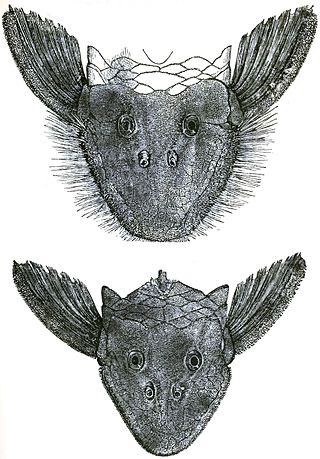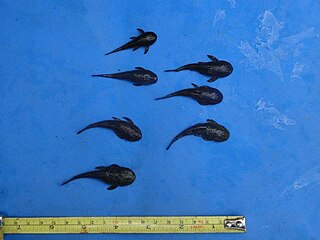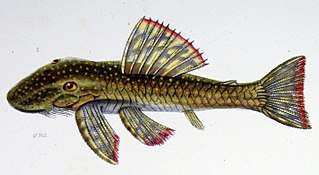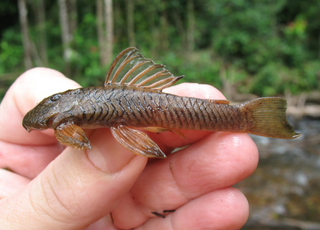
Ancistrus is a genus of nocturnal freshwater fish in the family Loricariidae of order Siluriformes, native to freshwater habitats in South America and Panama. Fish of this genus are common in the aquarium trade where they are known as bushynose or bristlenose catfish. In the aquarium hobby they are often referred to as bushynose or bristlenose plecos instead, but this may lead to confusion as "pleco" usually is used for Hypostomus plecostomus and its allies and is often used as a catchall term for any loricariids remotely resembling that species.

The Loricariidae is the largest family of catfish, with 92 genera and just over 680 species. Loricariids originate from freshwater habitats of Costa Rica, Panama, and tropical and subtropical South America. These fish are noted for the bony plates covering their bodies and their suckermouths. Several genera are sold as "plecos", notably the suckermouth catfish, Hypostomus plecostomus, and are popular as aquarium fish.

Hypostomus is a genus of catfish in the family Loricariidae. They are native to tropical and subtropical South America. H. plecostomus is the popular freshwater aquarium fish formerly known as Plecostomus plecostomus. The taxonomic structure of the Loricariidae is still being expanded by scientists. Hypostomus is a highly species-rich and widely distributed catfish genus.

Pseudorinelepis genibarbis is a species of armored catfish native to Brazil, Peru and Ecuador where it is found in the Amazon basin.
This glossary of ichthyology is a list of definitions of terms and concepts used in ichthyology, the study of fishes.

Acanthicus is a genus of large, South American suckermouth armored catfishes native to the Amazon and Orinoco basins, and possibly in Guyana. The name Acanthicus is derived from the Greek, akanthikos meaning thorny, spiny. Fish of this genus are known as lyre-tail plecos. These species are found in large rivers, primarily in areas with a rocky bottom and a moderate or strong current.

Pseudancistrus is a genus of suckermouth armored catfishes native to South America.

Hypancistrus is a genus of loricariid catfish originating from the Amazon basin in South America. Unlike many of the other Loricariids, however, some Hypancistrus species are more carnivorous and enjoy meat in their diet. Hypancistrus species are popular aquarium fish, including such popular fish as the zebra pleco and Queen Arabesque pleco.

Peckoltia is a genus of small South American armored suckermouth catfishes. Many of these fish are popular aquarium fish.

Corymbophanes is a genus of armored catfish native to South America where they are only known from Guyana. Corymbophanes was originally placed in its own tribe Corymbophanini, but the first comprehensive molecular phylogenetic analysis of the subfamily Hypostominae found Corymbophanes to be nested within the tribe Ancistrini.
Pogonopoma is a genus of armored catfish native to rivers in south and southeast Brazil.

Rhinelepis is a genus of South American armored catfish.

The Hypostominae are a subfamily of catfishes of the family Loricariidae. Most members are restricted to tropical and subtropical South America, but there are also several species in southern Central America. Hypostomus plecostomus, which is popular in the aquarium trade, has been introduced to several regions far from its native range.

Ancistrini is a tribe of catfishes of the family Loricariidae. Most are restricted to tropical and subtropical South America, but there are also several genus in southern Central America.
Dekeyseria is a genus of suckermouth armored catfishes native to tropical South America.

Lasiancistrus is a genus of suckermouth armored catfishes. They are native to South America and Panama.
Breitensteinia is a genus of catfishes of the family Akysidae. It includes three species.
Pseudolithoxus is a genus of suckermouth armored catfishes with five described species from the basins of the Orinoco, Casiquiare and upper Rio Negro in Venezuela. Additionally, a possibly undescribed species is known from the Trombetas and Nhamundá rivers in Brazil.
Andeancistrus is a genus of suckermouth armored catfishes native to South America. This genus is diagnosable from all other members of the Chaetostoma group by having a fully plated snout, lacking cheek odontodes that extend past the opercular flap, and by having eight branched dorsal fin rays.

Guyanancistrus nassauensis is a species of catfish belonging to the family Loricariidae, the suckermouth armored catfishes. It is discovered in 2005 and formally described in 2018. G. nassauensis is a rare species, highly endemic to the Nassau Mountains in Suriname, and is threatened with extinction by proposed or ongoing mining activities.













